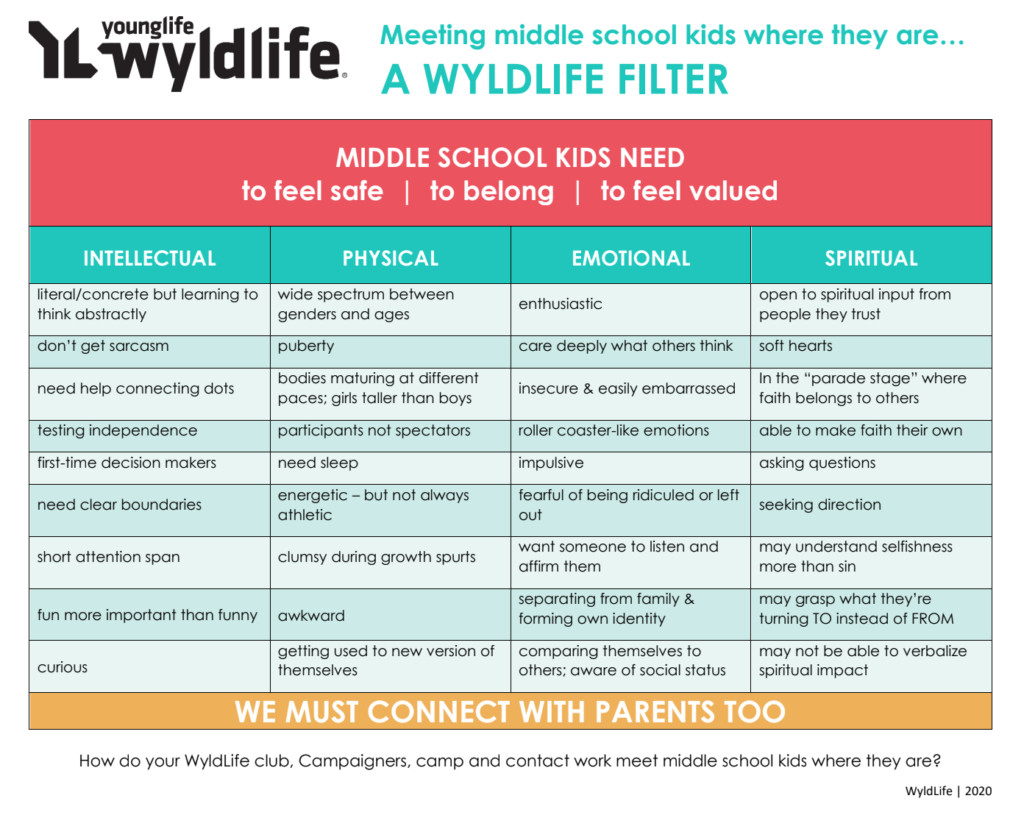Early adolescence is one of the most significant periods of development in a person’s life, second only to the transition from infant to toddler. Middle schoolers experience a flood of emotional, intellectual, and physical changes.
When WyldLife leaders understand the development of early adolescents, we can more compassionately and effectively walk through life with them.
BODY IMAGE.
Clothes, cosmetics, time in the bathroom, hair, physique, and the latest trends become important. Many of these physical changes can take on the appearance of awkwardness (cracked voice, clumsy movements, sloppy appearance) rather than elegance.
Support, not ridicule, is what they need. WyldLife leaders need to affirm, whenever possible, the growth they notice. Kids are insecure and aware of the changes taking place that they cannot control.
DECISION MAKING.
Younger adolescents are beginning to make choices on their own. They want to be their own person, but at the same time, they desperately want to belong and often will follow whatever the “group” is doing. The prefrontal cortex (decision-making center of the brain) is under development which means kids can’t consistently make positive decisions or think through long-term consequences.
Adult guidance, not control, is important at this point. Allow them to stumble, learn from their mistakes, and move on with more confidence the next time they make a decision. WyldLife leaders should stay near enough to listen and offer counsel.
INSECURITY.
With parents: The separation process begins. As they separate from parents they are searching for someone older to follow and copy. Withdrawal, closed doors, and silent treatment are often symptoms of insecurity.
With peers: Comparison, moods, competition, and choices are going on all of the time. Best friends change frequently. Loyalty is real but not always lasting.
With other adults: They may be too insecure or embarrassed to initiate, so most early adolescents wait to respond to adults. Once an adult steps into their world, kids will often respond because they feel noticed and affirmed.
Introduce yourself to kids, learn names and build relationships with them.
CHANGING THOUGHT PROCESSES.
WyldLifers are literal thinkers with short attention spans. Thought processes are still concrete at this age, but they are intrigued with abstract thoughts and excited when they “get it.” Their brains are shedding what they don’t need and keeping what is repeated. They are learning how to connect issues and ideas.
Respect, discussion and support are needed when kids are developing new and different kind of thought patterns. We must be committed to teaching kids how to ask questions, discover, and think through things rather than just giving them the answers.
COMMUNICATION.
Verbal responses are usually short and incomplete because communication skills are not well-developed. Discussion of feelings is infrequent. Judging, criticizing and exaggeration are typical. Kids spend most of their time communicating over social media. They may use their online interactions to cover up who they really are or what they actually are feeling.
Do not let immature conversation patterns lead you to believe that personal impact is not happening. Be patient. Know that they are more than what you see on social media.
EMOTIONS.
Young adolescents are driven by emotions. Hormones and feelings are constantly running interference with anything you are trying to get across. Everything is mediated through how they feel. What you see is what they feel – not necessarily what they think.
Don’t get caught up in the roller coaster of their emotions.
SEASON OF FIRSTS.
Kids experience more “firsts” in middle school than at any other time in their lives. They are going to schools with multiple classes and teachers each day. They are trying out/auditioning for teams and performances. They are using social media, going to school dances, and finding their own friends.
Put yourself in their shoes and remember the difficulties of middle school.
SPIRITUAL OPENNESS.
Studies suggest that there is no more optimum time in one’s life to be influenced by spiritual truth than during the early teenage years. Impact is hard to measure because they may not know how to communicate spiritual information. What attracts middle-school kids to the Gospel is not always guilt over sin and what Jesus did for them, but more that Jesus loves us and knows us.
Notice and affirm behavior, attitude and relationship patterns more than verbal responses. Tell them often about the hope and love found in Jesus.

The WyldLife Filter summarizes many of these characteristics and can be a useful tool as you find ways to meet middle school kids where they are. When WyldLife leaders understand early adolescent development, they can build more impactful friendships with middle school kids, prayerfully hoping that kids will grow into lifelong relationships with Christ.




